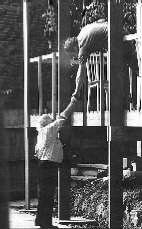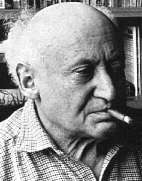 |  | |||||||||
 | |||||
WALTER SEGAL - Community Architect by Colin Ward
The name of the late Walter Segal is now synonymous with self build housing. Whenever people meet to discuss what they could do to house themselves, someone mentions the Segal system of quickly-built, timber-framed dwellings which are environmentally friendly, and seem to generate friendship among the self build groups that have succeeded in housing themselves this way. The attraction increases when we learn that they include men and women with every kind of background, and they often say that the experience changed their lives.
The heartbreaks and delays that self builders experience are not to do with the process of building itself, but, as Walter Segal used to observe, are the result of the inflated price of land, the rigidities of planning and building controls, and the difficulty of getting mortgage loans for anything out of the ordinary. They are all made worse by the assumption of both regulatory authorities and providers of finance, that a house should be a full-finished product right from the start, rather than a simple basic structure that grows over time as needs grow and as labour and income can be spared. Segal’s achievement was to devise a way of simplifying the process of building so that it could be undertaken by anyone, cheaply and quickly. He insisted that his was an approach, not a system, and he made no claims for originality or patents.
The Segal approach was essentially that of the medieval English house, or the American frame-house, or the Japanese house, but with the timber frame calculated and based on modular dimensions to avoid waste and to facilitate alterations and enlargements. He sought to eliminate or reduce the ‘wet trades’ of concreting, bricklaying and plastering, by reducing the sheer weight of the building and by using cladding, insulating and lining materials in their standard sizes. In his life, as well as his work, he tried to pare away the superfluous and concentrate on the important. My purpose is not to describe the Segal method, but to recount the effect on his life and personality of growing up in an anarchist commune, and his evolution late in life, as the architect, friend and advisor of community self builders.
Walter’s parents were Jewish Romanians who met in Berlin, where his father, an expressionist painter, was taking part in an exhibition of the group called the New Secession. Walter was born in 1907 and in 1914 the family moved to the hills above Ascona in the Swiss canton of Ticino. Close by, in 1900, a colony had been started, trying, as Walter explained, “to find a new meaning in life,” and was called Monte Verita, the Mountain of Truth. Like the aspirations of, say, Edward Carpenter’s hopes of new communities around Sheffield, it was a revolt against the appalling stuffiness, in clothing, diet and means of livelihood of the atmosphere of the late nineteenth century. Monte Verita was founded by Henri Odenkoven, a Fleming from Antwerp, and Karl Gruser, from the German minority in Hungary, whose younger brother Gustav, wandering through Germany “with long hair, sandals and bare legs” was met by the writer Herman Hesse, who followed him down to the colony and spent most of his life there. It figures in the lives of many subsequently famous writers, painters and revolutionaries.
Segal recalled that: “The colonists abhorred private property, practised a rigid code of morality, strict vegetarianism and nudism. They rejected convention in marriage and dress, party politics and dogmas: they were tolerantly intolerant.” He reflected that “To have spent childhood and adolescence in an environment of artists, writers, life-reformers, thinkers and truth seekers, ideologues and mystics, charlatans and cranks, many of whom have left their mark upon our time - and unfortunately perhaps, continue to do so - was in a way a singular piece of good luck; but there were moments when I longed for ordinariness and went to seek it.”
He found it among the village children, untrammelled by seriousness. “So I had playmates in both camps which meant that I was affected by the lives of both the Bohemians and the ordinary philistines. And I have since found myself all the time moving from one camp to the other, never really able to adjust to one world only.” He was an outdoor child and realised early in life that his work was to be in building. “So I gradually slid into an understanding of how buildings are put up, and it was clear to me by the age of fourteen that I was going to be an architect.” And he was fortunate in picking up an American house-carpenter’s manual on the ordinary American tradition of ‘balloon-frame’ building of houses and barns.
The family were living in poverty, but suddenly a patron appeared for the painter Arthur Segal in the form of a rich anarchist sympathiser, Bernhard Mayer, and Walter was enabled to study architecture among the pioneers of the Modern Movement in Delft, Berlin. In Berlin, learning from engineers, he resolved that “every building I was going to make, I would calculate” and he won a scholarship to finish his education at the Technische Hochschule in Berlin.
In 1932 he was commissioned by the same Bernhard Mayer to build a little wooden holiday cabin, La Casa Piccola, at Ascona. It is still standing and has many of the characteristics of the Segal-style houses that self build cooperatives are putting up around the United Kingdom today. “I went back to Ascona to build,” Segal recalled, “It became clear to me that one can have a small path and tread it alone.” He was undoubtedly shaped by shaped by the free-thinking influences of his childhood... the architectural critic Peter Blundell Jones was right in saying that “At Monte Verita, Walter saw enough artistic self-indulgence to last a lifetime,” but he was also right in perceiving that “Walter was already steeped in far too rich and broad a culture and had become too much of a lone wolf ever to join any pack. He had to find his own way in everything, and confessed that he could never submit to authority.”
Hard times and a happy accident
Walter came to London in 1936, teamed up with Eva Bradt, a student from the Architectural Association School, and scraped a living on the fringe of the architectural world, during and after the second world war, writing prolifically in the trade journals and teaching at the Architectural Association School. As housing was bound to be a key post-war issue, he wrote a massive book Home and Environment (Leonard Hill 1948, 1953) and another on an issue which is more topical today than it was then, Planning and Transport: Their Effects on Industry and Residence (Dent, for the Cooperative Permanent Building Society, 1945). Books bring prestige but not an income and the post-war building boom passed him by. A handful of well connected left-wing architects had a huge output of housing and schools. They would not have taken seriously the small jobs that came to Walter: little buildings in Hackney for the Premium Pickle Company or a small office for Tretol Ltd and a few self-generated housing projects. Professional rejection meant nothing to him. He had a happy family life, was incredibly well read in several European languages and was a familiar figure in the architecture schools. I first met him when I went to talk at one of them and found a knot of students towering over a small, round, twinkling man pouring out a stream of paradoxes in a very soft voice. And his subsequent fame came by accident. Eva died in 1950 and a decade later Walter and a new partner, Moran Scott, with six children between them, decided to demolish and rebuild their home at Highgate and to put up a temporary house at the bottom of the garden to live in meanwhile. The lightweight timber structure, with no foundations other than paving slabs, and using standard cladding materials and linings in market sizes (enabling their reuse) took two weeks to build and cost £800.
It is there to this day, snug as ever. I remember sleeping in it when I was only 20 years old, with deep snow all around. Visitors to the Segals were more interested in the little house in the garden than in their new house on the street front. It led to a series of commissions around the country for houses built on the same principle, with Walter refining and improving the method every time. A carpenter, Fred Wade, followed him from site to site, and everywhere the clients were able to do more and more of the building theselves, varying the plans to suit their needs and make additions.
By the mid-1970s, as the crisis of confidence in local authority housing deepened, Walter was yearning to find one council that would sponsor a build-it-yourself experiment of this kind for people on its housing waiting or transfer list. Eventually, by one vote, the London Borough of Lewisham decided to do so, on pockets of land too small, awkward or sloping, to fit its own building programme. There were two and a half years of agonising delay, simply because the proposal didn’t fit the standard ways of financing, providing or controlling buildings, but in the end it happened. Everyone involved was delighted. Ken Atkins of the Lewisham Self Build Housing Association reflected on what he called the “indescribable feeling that you finally have control over what you are doing.” And Segal himself, in the context of the universal gloom hanging over housing in Britain was overjoyed to have helped to prove in the most convincing way imaginable “that there is among the people that live in this country such a wealth of talent.” He found it unbelievable that this creativity would continue to be denied an outlet.
The Segal Legacy
Walter died, aged 78, in October 1985. Within the architectural world his role had shifted from that of a loner and outsider to that of a moral force both inside and outside the profession. He is the only contemporary architect to have two roads named after him: Segal Close and Walter’s Way, tokens of the affection he inspired among self builders. When I last talked to him a few weeks before his death, he was bubbling with enthusiasm about a demonstration structure at the Centre for Alternative Technology at Machynlleth in Wales, and about a building his stepson was putting up on his smallholding, with three big frames, erected, like an American barn-raising, by emptying the local pub one weekend lunchtime. His friends and the people who had changed their lives by building Walter’s Way set up the Walter Segal Self Build Trust to propagate the message and slowly, around Britain, examples of his approach to house building could be found. They are among the few bright lights in the dismal housing climate of the 1990s. Just as he hoped, his successors have continually adapted his approach to meet their own needs, and to changing assessments of environmentally-friendly materials and standards of construction.
This article originally appeared in Diggers and Dreamers: A Directory of Alternative Living and is reproduced with the kind permission of the author. | |||||
Walter Segal with Ken Atkins | |||||
 | |||||
Walter Segal | |||||